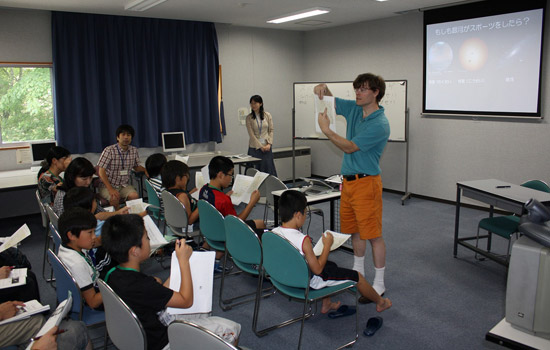RIT Scientist has astronomical adventure in Japan
Physics professor Michael Richmond completes summer fellowship
Submitted
Michael Richmond, professor of physics, conducted astronomical research this summer in Japan. Here, he takes a moment from his work to talk to fourth-graders visiting the Kiso Observatory in the town of Agematsu. Their teacher, Fujinuki-san, helped Richmond explain the difference between stars, galaxies and planets. “We tried to show how galaxies are relatively close to each other, and planets are not so close to each other, but stars are really far from each other.”
RIT physics professor Michael Richmond took a different route to work this summer. Instead of the familiar commute to campus and the RIT Observatory on John Street, he navigated the narrow mountain road to the Kiso Observatory in central Honshu, Japan. Richmond stayed for a month in Agematsu, the small town at the base of the mountain, during the second half of his fellowship with the Japanese Society for the Promotion of Science.
“Driving has been a bit of an adventure: It’s on the wrong side of the road, and most of the road up the mountain is a narrow, 1.5-car-width-strip with no separate lanes. But I’ve managed to survive.”
Before traveling to Agematsu, Richmond spent the first four weeks of his two-month fellowship working with students and professors at the University of Tokyo’s Institute of Astronomy in Mitaka, a suburb of the capital. His colleague Mamoru Doi, a professor at the institute and a collaborator, sponsored Richmond for the fellowship, his second extended research trip to Japan since 2008.
The tragedy of the 8.9 magnitude earthquake, tsunami and nuclear meltdown on the east coast in March hung in the background of Richmond’s trip. He arrived in Japan for his two-month visit in June in the midst of a slow-moving recovery effort. Richmond notes, however, that the events had little impact on his time in Tokyo or at the Kiso Observatory.
“This region [Nagano] has been spared most of the ills from the big earthquake and nuclear problems,” he says.
Richmond concentrated on helping his Japanese colleagues write software to process raw images captured by the new Kiso Wide Field Camera on the observatory’s 1.05-meter Schmidt telescope.
“The new camera consists of a mosaic of eight big CCD [charge-coupled device] chips,” he says. “It covers a very wide area, about 2-by-2 degrees on a side. The wide field makes this camera a powerful tool for surveys of large areas of the sky.”
Large scans of the sky are maps to the universe. Astronomers use them to look for, among other things, bright supernovae, or exploding stars, that act as markers for measuring distances to faraway galaxies.
Prior to joining RIT in 1997, Richmond wrote software to clean up raw data captured by the Sloan Digital Sky Survey, an ambitious effort that began mapping the sky with sensitive electronic detectors in the early 1990s.
“More and more of astronomy is taken up with the question of writing computer programs,” Richmond says. “And less and less is going out at night to look through an eyepiece because the detectors we use are digital and produce digital images.”
Conversing with his colleagues about science and software has been challenging for Richmond, whose grasp of conversational Japanese language—handy for ordering food and asking for directions—doesn’t include technical vocabulary.
“Fortunately, my colleagues are much better in English than I am in Japanese,” Richmond says. “It was a humbling experience to attend a two-day workshop at the observatory, as all the talks were given in Japanese. I was the only non-Japanese person present.”












